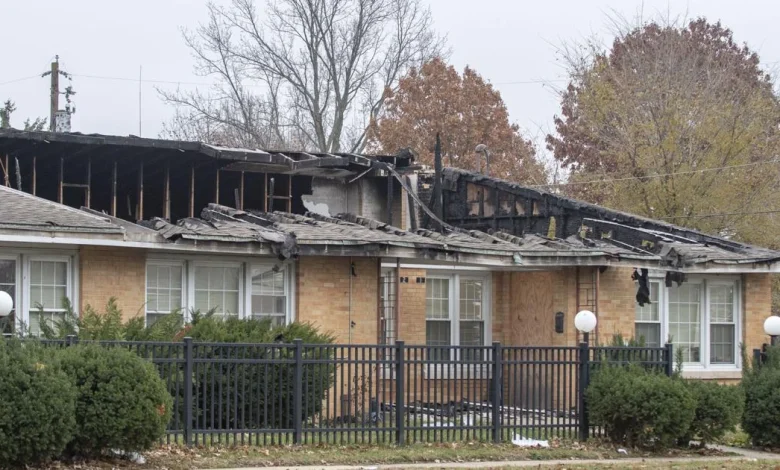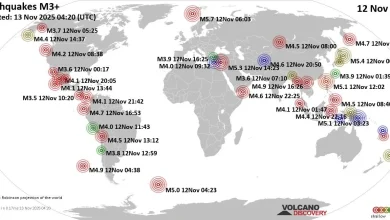North End residents want to see repairs, not redevelopers

To subscribe, click here.
To submit a letter to the editor, click here.
CHAMPAIGN — Residents of the city’s North End are in favor of repairs to low-income housing for seniors at the corner of North Fifth Street and East Columbia Avenue, which was damaged in a fire in July 2024.
At the same time, they hope that a proposed rezoning to facilitate the work doesn’t open the door for development that might change the face of their neighborhoods.
“The residents of the North End do not wish to see our community reshaped to mirror what is happening in Campustown,” said the Rev. James Wright, pastor at Sheriff’s Temple AOH Church of God at 601 E. Vine St. “We want safe neighborhoods, affordable housing for seniors, and thoughtful planning, not speculative redevelopment.”
The Champaign Plan Commission voted on Nov. 19 to forward a request to rezone 501 and 503 E. Columbia Ave. from Single-Family (SF1) to Multifamily Low Density (MF1) to the city council with a positive recommendation. The matter will be on the council’s Dec. 2 agenda, said Senior Planner Eric Van Buskirk.
The proposed rezoning was initiated by Champaign Planning and Development Director Bruce Knight and is being done in collaboration with the Housing Authority of Champaign County, which owns the properties, said Associate Planner Lily Wilcock.
Commissioner Jeffrey Barkstall abstained from the vote, stating that the housing authority is one of his clients as a Realtor. He added that he has not been involved with this particular property.
The two buildings were constructed by HACC to be multi-family residences for low-income seniors, but their zoning was later shifted due to changes made by the city, Wilcock wrote in a report to the commission. HACC seeks to repair 501 E. Columbia Ave. and make all eight units in the building livable once more.
“It was pretty severe,” said HACC Executive Director Lily Walton. “The roof kind of caught on fire.”
No one was hurt, but eight residents were displaced, she said. These individuals were relocated to other properties in the housing authority’s portfolio.
The fire occurred on July 1, 2024. The Champaign Fire Department arrived at the scene at 11:36 p.m. after receiving a report from a passer-by. Upon their arrival, firefighters found a growing fire and went into the building to investigate, which led them to discover “a fast-moving attic fire,” fire officials said at the time.
The crews then adopted a “defensive strategy” and used aerial ladders to bring the blaze under control. The fire was deemed an accident caused by “energized electrical equipment,” officials said.
“The fire-damaged structure has been exposed to the elements since that time,” Wilcock wrote. “The structure is in dire need of repair and cannot be repaired as a non-conforming structure.”
She added that the city’s neighborhood services and legal department issued an order in July 2025 that the structure be demolished or repaired — with demolition being the only option unless the rezoning is approved.
Walton told The News-Gazette that the housing authority has a contract in place for the repairs, which would begin immediately if the rezoning is granted. She estimated that the work would be complete in the summer or fall of 2026.
When asked why repairs did not happen sooner, Walton replied that it took the housing authority “a little while” to secure an architect for the project.
“From there, they had to complete the drawings, and then we had to put it out for bid, and so it took a little longer,” she said, adding that the housing authority was also dealing with some “administrative turnover” at the time.
Once repaired, the building will continue to offer low-income senior housing, she said.
According to Wilcock, the history behind this case dates back to 1961, which is when the city approved the housing authority’s request to rezone vacant property at North Fifth Street and East Columbia Avenue from single-family residential to multifamily residential.
“In response to housing affordability concerns and housing condition concerns, the city of Champaign worked with the housing authority to make low-income senior housing in this area,” she said.
The two buildings, which contain a total of 16 units, opened to residents in 1962.
The city later approved a general neighborhood plan for northeast Champaign to facilitate further affordable housing development in partnership with HACC and the Public Housing Authority, a precursor to the U.S. Department of Housing and Urban Development, Wilcock said.
Recommendations from the plan, which was adopted in 1963, were incorporated into a new zoning map drawn up the city a couple years later, as were major changes to the city’s zoning ordinance.
“The 1965 Zoning Map included modified zoning districts, and the subject properties appear in an area of R-2, Single-family Medium Density,” Wilcock said. “The new zoning map was a broad City-wide rezoning process. Unlike today’s process, the mass new zoning map did not consider the effects of rezonings at the parcel level.”
As a result, the two buildings became “legally non-conforming” structures. The zoning district was later updated to SF1 when terminology changed under the 1996 zoning ordinance, city planning officials said.
During the time for public comment, Wright read a statement on behalf of residents of the city’s North End.
“The housing authority has maintained this building over 60 years and remained a valuable source of affordable small-scale senior housing in our community,” he said. “Many of our elders relied on these units for stable living, and restoring them is both reasonable and humane.”
Therefore, residents would support a “limited rezoning” solely for the purpose of repairs.
However, Wright went on to say that North End residents are “strongly opposed” to the potential rezoning being interpreted as an “open door for developers to begin requesting additional zoning northward, using this property as a precedent for larger development interests.”
Wilcock told the plan commission that planning staff met with six residents of the area surrounding the subject property on Nov. 17 and listened to their concerns, which largely mirrored those voiced by Wright.
James Lee, the housing authority’s director of construction and real-estate development, later said that the agency “is fully committed to the preservation of the community intention and the culture shared amongst all of you.”
Planning staff also noted that if this particular site ever were to be redeveloped, the proposed MF1 zoning would limit the scope of what could be built.
According to Van Buskirk, this zoning district is intended to facilitate multifamily development “at a scale that is compatible with single-family.”
“The height and the setbacks match the single-family district,” he said.
Wilcock also noted that parking requirements and floor-area ratios would also serve as limiting factors to any potential redevelopment on the lot, which is only about 0.6 acres.
Additionally, it is rare for the city to initiate a rezoning application, and the request at hand is limited to the land at 501 and 503 E. Columbia Ave., Van Buskirk said.
“We do get requests as a city … ‘Hey, this property is for sale, what about, can I get a rezoning to X?’ Could be a commercial district, it could be high-density multifamily,” he said. “We do not entertain those right now, in particular in this neighborhood, because we understand the sensitivity around the encroachment of Campustown development into this particular area. And so I just want to take a minute to clarify that, that this is not a speculative rezoning on behalf of a developer. This is to support the senior housing that’s currently in place.”





